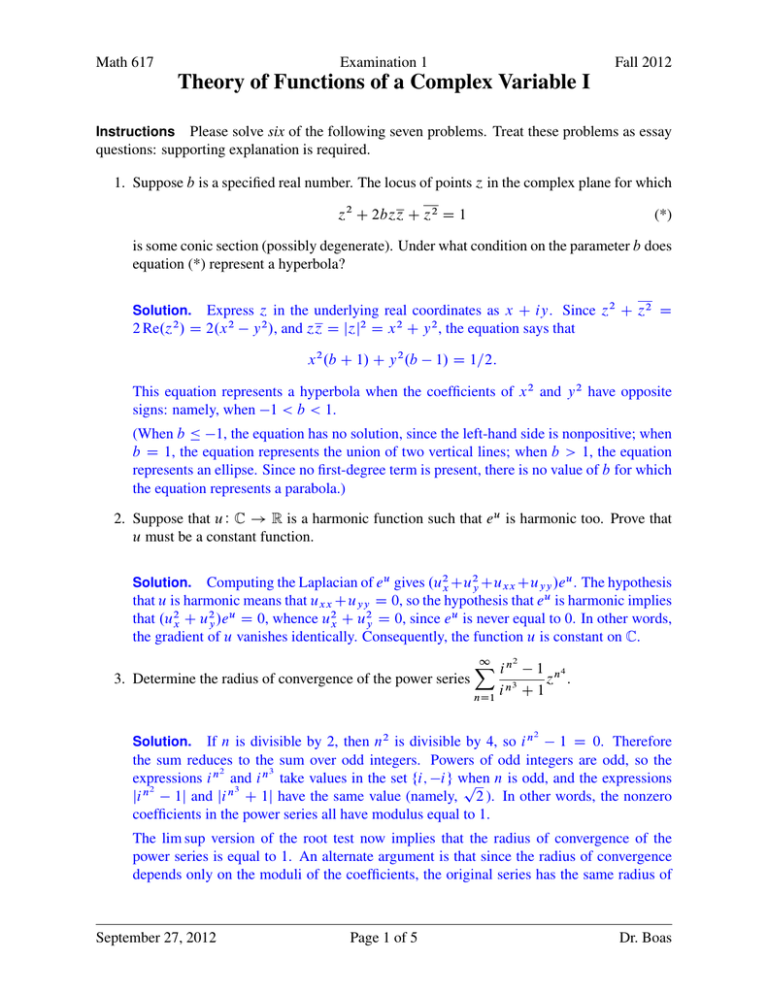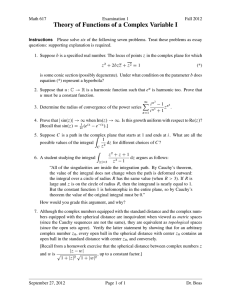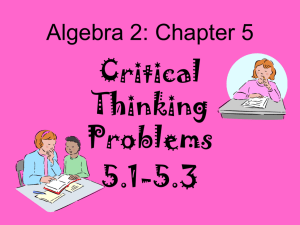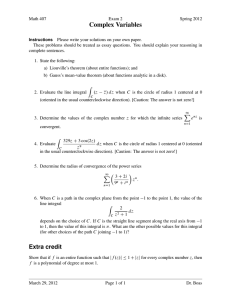Theory of Functions of a Complex Variable I
advertisement

Math 617 Examination 1 Fall 2012 Theory of Functions of a Complex Variable I Please solve six of the following seven problems. Treat these problems as essay questions: supporting explanation is required. Instructions 1. Suppose b is a specified real number. The locus of points ´ in the complex plane for which ´2 C 2b´´ C ´2 D 1 (*) is some conic section (possibly degenerate). Under what condition on the parameter b does equation (*) represent a hyperbola? Express ´ in the underlying real coordinates as x C iy. Since ´2 C ´2 D 2 Re.´2 / D 2.x 2 y 2 /, and ´´ D j´j2 D x 2 C y 2 , the equation says that Solution. x 2 .b C 1/ C y 2 .b 1/ D 1=2: This equation represents a hyperbola when the coefficients of x 2 and y 2 have opposite signs: namely, when 1 < b < 1. (When b 1, the equation has no solution, since the left-hand side is nonpositive; when b D 1, the equation represents the union of two vertical lines; when b > 1, the equation represents an ellipse. Since no first-degree term is present, there is no value of b for which the equation represents a parabola.) 2. Suppose that u W C ! R is a harmonic function such that e u is harmonic too. Prove that u must be a constant function. Computing the Laplacian of e u gives .u2x Cu2y Cuxx Cuyy /e u . The hypothesis that u is harmonic means that uxx Cuyy D 0, so the hypothesis that e u is harmonic implies that .u2x C u2y /e u D 0, whence u2x C u2y D 0, since e u is never equal to 0. In other words, the gradient of u vanishes identically. Consequently, the function u is constant on C. Solution. 2 1 X in 1 n4 3. Determine the radius of convergence of the power series ´ : 3 n i C1 nD1 2 If n is divisible by 2, then n2 is divisible by 4, so i n 1 D 0. Therefore the sum reduces to the sum over odd integers. Powers of odd integers are odd, so the 2 3 expressions i n and i n take values in the set fi; ig when p n is odd, and the expressions 2 3 ji n 1j and ji n C 1j have the same value (namely, 2 ). In other words, the nonzero coefficients in the power series all have modulus equal to 1. Solution. The lim sup version of the root test now implies that the radius of convergence of the power series is equal to 1. An alternate argument is that since the radius of convergence depends only on the moduli of the coefficients, the original series has the same radius of September 27, 2012 Page 1 of 5 Dr. Boas Math 617 Examination 1 Fall 2012 Theory of Functions of a Complex Variable I X convergence as the series 4 ´n . This series evidently diverges when ´ D 1, so the odd n 4 radius of convergence is no greater than 1. But if j´j < 1, then j´n j j´jn , so the series converges by comparison with a geometric series. Thus the series converges everywhere inside the open unit disk and diverges everywhere outside the open unit disk. 4. Prove that j sin.´/j ! 1 when Im.´/ ! 1. Is this growth uniform with respect to Re.´/? [Recall that sin.´/ D 2i1 .e i´ e i´ /.] Solution. Write ´ as x C iy and observe that by the triangle inequality, j sin.´/j 21 .je i´ j je i´ j/ D 12 .e y e y / 12 .e y 1/ when y 0. Evidently the lower bound tends to 1 with y, and the growth is independent of x. An alternate method is to compute that j sin.´/j2 D .sin x/2 C .sinh y/2 , so the conclusion again follows. 5. Suppose C is a path in the complex plane that starts at 1 and ends at i . What are all the Z 1 possible values of the integral d´ for different choices of C ? 2 C ´ If C passes through the point 0, then the integral is undefined (more precisely, is a divergent improper integral). In all other cases, the integral has a well-defined, path-independent value, for the integrand 1=´2 has an anti-derivative (namely, 1=´) valid everywhere on the path. Thus Solution. Z C 1 d´ D ´2 1 ´ i D 1 1 1 C D 1 C i: i 1 ´2 C ´ C 1 d´ argues as follows: ´2 1 j´jD3 “All of the singularities are inside the integration path. By Cauchy’s theorem, the value of the integral does not change when the path is deformed outward: the integral over a circle of radius R has the same value (when R > 3). If R is large and ´ is on the circle of radius R, then the integrand is nearly equal to 1. But the constant function 1 is holomorphic in the entire plane, so by Cauchy’s theorem the value of the original integral must be 0.” Z 6. A student studying the integral How would you grade this argument, and why? September 27, 2012 Page 2 of 5 Dr. Boas Math 617 Examination 1 Fall 2012 Theory of Functions of a Complex Variable I The student does not get full marks, for the answer is wrong. But the method is a good one that will work if implemented more carefully. Solution. Cauchy’s theorem certainly implies that subtracting 1 from the integrand does not change the value of the integral. Now ´2 C ´ C 1 ´2 1 1D ´C2 : ´2 1 R When ´ has large modulus, the right-hand side is roughly 1=´, and j´jDR ´1 d´ D 2 i . The value of the original integral is indeed 2 i . What the student missed is that this “lower-order” term is actually the one that determines the value of the integral. [To check that there is no additional contribution to the integral from a further lower-order term, observe that ´2 C ´ C 1 ´2 1 Therefore 1 1 2´ C 1 D D O.1=R2 / 2 ´ ´.´ 1/ Z j´jDR when j´j D R. ´2 C ´ C 1 d´ D 2 i C O.1=R/ ´2 1 since the modulus of an integral is at most the maximum modulus of the integrand on the integration path times the length of the path. Letting R tend to 1 proves that the original integral has value 2 i .] 7. Although the complex numbers equipped with the standard distance and the complex numbers equipped with the spherical distance are inequivalent when viewed as metric spaces (since the Cauchy sequences are not the same), they are equivalent as topological spaces (since the open sets agree). Verify the latter statement by showing that for an arbitrary complex number ´0 , every open ball in the spherical distance with center ´0 contains an open ball in the standard distance with center ´0 , and conversely. [Recall from a homework exercise that the spherical distance between complex numbers ´ j´ wj , up to a constant factor.] and w is p p 1 C j´j2 1 C jwj2 There are several ways to approach this question. What follows is intended as a general discussion of various ways to think about the problem, not as a model of how you might write an answer during the exam. Solution. Let the notation d.´; w/ denote the indicated expression for the spherical distance. There is no loss of generality in supposing that the constant factor is equal to 1. In topology, a continuous function is characterized by the property that the inverse image of every open set is open. Accordingly, the statement of the problem can be rephrased September 27, 2012 Page 3 of 5 Dr. Boas Math 617 Examination 1 Fall 2012 Theory of Functions of a Complex Variable I in the language of topology as saying that the identity map (sending ´ to ´) between the metric spaces .C; j j/ and .C; d / is a homeomorphism (a one-to-one and onto map that is continuous and has a continuous inverse—in fancier language, a bicontinuous bijection). Rephrased in terms of a geometric model, the statement says that stereographic projection is a homeomorphism between the complex plane (equipped with the standard topology) and the sphere minus the north pole (equipped with the subspace topology inherited from the ambient three-dimensional Euclidean space). In a homework exercise, you computed formulas for stereographic projection and its inverse, so you know that stereographic projection is a bijection. Moreover, the formulas that you obtained are rational functions of the coordinates in R2 and R3 . Consequently, these formulas do represent continuous functions except at the zeroes of the denominators. You observed that the zeroes in the denominators correspond precisely to the north pole of the sphere, a point that is not in the picture for the problem at hand. In other words, if you think about the problem in the language of topology, then you can reduce the problem to a homework exercise that you solved previously. In the field of analysis, however, the usual goal is to obtain a quantitative answer. How can that goal be attained in this problem? First observe that since d.´; w/ j´ wj for all complex numbers ´ and w, a standard ball is always inside the corresponding spherical ball with the same center and radius. Accordingly, what needs to be shown to solve the problem is that a standard open ball with center ´0 and positive radius r contains a spherical open ball with center ´0 and some positive radius. One way to finish the solution is to argue by contradiction. Could it be the case that for every positive integer n, the spherical ball with center ´0 and radius 1=n fails to be completely inside the standard ball with center ´0 and radius r? If that happened, then there would be a sequence f´n g1 nD1 such that j´0 ´n j r 1 > d.´0 ; ´n / D p p : p p n 1 C j´0 j2 1 C j´n j2 1 C j´0 j2 1 C j´n j2 Since the left-hand side approaches 0 as n increases, so does the right-hand side. Therefore j´n j ! 1 when n ! 1. But then the definition of the spherical distance implies that lim d.´0 ; ´n / D lim p n!1 n!1 j´0 ´n j 1 Dp ; p 1 C j´0 j2 1 C j´n j2 1 C j´0 j2 contradicting the hypothesis that limn!1 d.´0 ; ´n / D 0. This argument by contradiction still does not give a quantitative estimate on the size of a spherical ball contained in the standard ball with center ´0 and radius r. Here is a calculation that does give such an estimate. There is no loss of generality in supposing that r < 1. Working momentarily in the extended complex numbers, observe that d.´0 ; 1/ D lim p ´!1 September 27, 2012 j´0 ´j 1 Dp : p 1 C j´0 j2 1 C j´j2 1 C j´0 j2 Page 4 of 5 Dr. Boas Math 617 Examination 1 Fall 2012 Theory of Functions of a Complex Variable I I claim that the spherical open ball with center ´0 and radius 2r d.´0 ; 1/2 is contained in the standard open ball with center ´0 and radius r. To see why, notice first that if ´ is in this spherical ball, then d.´0 ; ´/ < 21 d.´0 ; 1/ (since r < 1 and d.´0 ; 1/ 1), so the triangle inequality implies that d.´; 1/ > 21 d.´0 ; 1/. Moreover, if ´ is in this spherical ball, then j´0 ´jd.´0 ; 1/d.´; 1/ D d.´0 ; ´/ < 2r d.´0 ; 1/2 ; so j´0 ´j < r d.´0 ; 1/ < r: 2 d.´; 1/ This inequality confirms that the indicated spherical ball is inside the standard ball of radius r. Yet another way to study the problem quantitatively is to manipulate the definition of the spherical distance directly. A spherical ball with center ´0 and radius s is defined by the following inequality: j´0 ´j < s; p p 1 C j´0 j2 1 C j´j2 or, equivalently, j´0 ´j2 < s 2 .1 C j´0 j2 /.1 C j´j2 /: Expanding the left-hand side and then collecting terms leads to the equivalent statement that 2 2 2 2 Re.´0 ´/ < s 2 .1 C j´0 j2 / j´0 j2 : j´j 1 s .1 C j´0 j / p It follows that when s < 1= 1 C j´0 j2 , the spherical ball is a standard ball (that is, disk) containing ´0 , although ´0 in general is not the center of this standard ball. (The center and the radius of this standard ball can be computed by completing the square.) If s is close to 0, then the radius of the standard ball is close to 0. It follows that every standard ball with center ´0 contains a small spherical ball with center ´0 . September 27, 2012 Page 5 of 5 Dr. Boas







